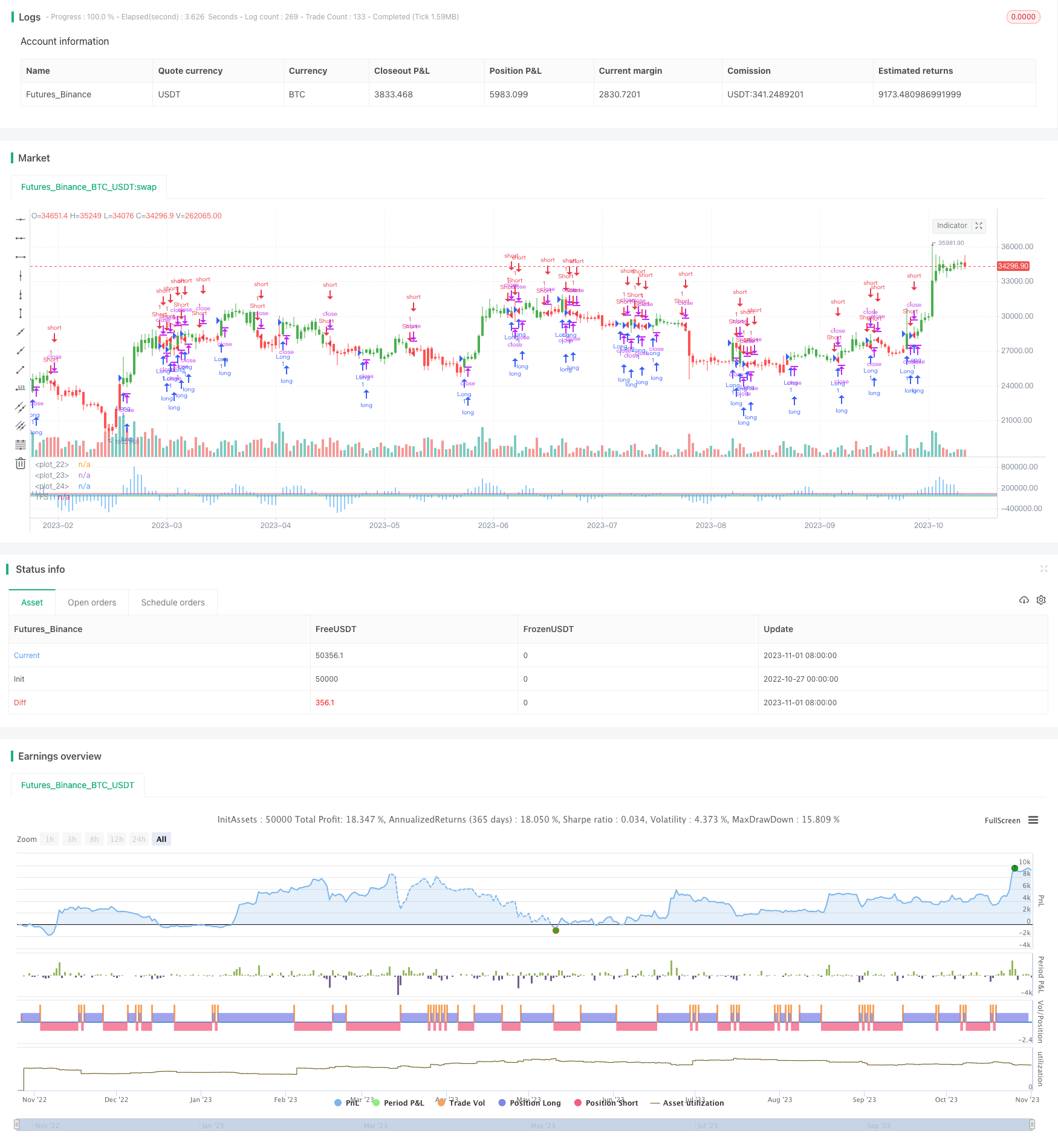
概述
基于交易量的趋势追踪策略通过计算交易量的多空比例,判断当前趋势方向,实现追踪趋势交易。该策略受到交易量指标(On-Balance Volume, OBV)的启发,通过计算close与open的关系判断交易量正负,再取N日移动平均构建指标,指标上穿上轨做多,下穿下轨做空。
原理
该策略主要通过以下步骤构建:
计算交易量正负:如果收盘价高于开盘价,该根K线的交易量记为正;如果收盘价低于开盘价,该根K线的交易量记为负;如果收盘价等于开盘价,该根K线的交易量记为0。
累加N日交易量正负值,得到累积交易量。
计算累积交易量的N日移动平均,得到最终指标值。
当指标上穿上轨时做多;当指标下穿下轨时做空。
这样通过交易量正负性判断趋势方向,再结合移动平均产生交易信号,可以有效跟踪趋势,捕捉中长线走势。
优势
基于交易量判断趋势更有说服力,交易量能反映市场参与者意愿。
结合移动平均平滑曲线,有利于跟踪趋势,减少频繁交易。
通过调整移动平均天数,可以适应不同周期的市场节奏。
通过上下轨组合,可以明确判断做多做空时机。
策略逻辑简单清晰,容易理解实现。
风险
存在指标发出错误信号的风险,跟踪趋势时也可能被困在震荡行情中。
在剧烈行情中,指标可能出现背离。
上下轨静态设定,无法动态适应市场波动。
未考虑止损策略,存在亏损扩大的风险。
移动平均存在滞后,可能错过趋势转折点。
优化思路
可以考虑结合其他指标进行组合交易,避免错误信号。
动态计算上下轨参数,使之能自适应市场波动。
增加止损机制,控制单笔亏损。
调整移动平均类型,适应市场节奏。
优化移动平均周期参数,提高顺势捕捉效果。
可以考虑在突破上下轨时,采用追踪止损来锁定利润。
总结
基于交易量的趋势追踪策略通过计算交易量正负性判断趋势,移平均产生交易信号,从而有效跟踪中长线趋势。该策略优势在于趋势判断准确,符合大多数交易者的长线操作习惯。但是也存在一定问题,需要进一步优化,使之能更好地应对市场的复杂性。总体而言,该策略为量化交易提供了一种简单实用的趋势追踪方案,契合大部分量化交易者的需求。
/*backtest
start: 2022-10-27 00:00:00
end: 2023-11-02 00:00:00
period: 1d
basePeriod: 1h
exchanges: [{"eid":"Futures_Binance","currency":"BTC_USDT"}]
*/
//@version=2
////////////////////////////////////////////////////////////
// Copyright by HPotter v1.0 15/12/2017
// This is the second part of TFS trading strategy. The concept of this
// indicator is similar to that of On-Balance Volume indicator (OBV). It
// is calculated according to these rules:
// If Close > Open, Volume is positive
// If Close < Open, Volume is negative
// If Close = Open, Volume is neutral
// Then you take the 7-day MA of the results.
//
// You can change long to short in the Input Settings
// WARNING:
// - For purpose educate only
// - This script to change bars colors.
////////////////////////////////////////////////////////////
strategy(title="TFS: Volume Oscillator", shorttitle="TFS: Volume Oscillator")
AvgLen = input(7, minval=1)
TopBand = input(40000, step=1)
LowBand = input(-35000, step=1)
reverse = input(false, title="Trade reverse")
hline(TopBand, color=red, linestyle=line)
hline(LowBand, color=green, linestyle=line)
hline(0, color=blue, linestyle=line)
xClose = close
xOpen = open
xVolume = volume
nVolAccum = sum(iff(xClose > xOpen, xVolume, iff(xClose < xOpen, -xVolume, 0)) ,AvgLen)
nRes = nVolAccum / AvgLen
pos = iff(nRes > TopBand, 1,
iff(nRes < LowBand, -1, nz(pos[1], 0)))
possig = iff(reverse and pos == 1, -1,
iff(reverse and pos == -1, 1, pos))
if (possig == 1)
strategy.entry("Long", strategy.long)
if (possig == -1)
strategy.entry("Short", strategy.short)
barcolor(possig == -1 ? red: possig == 1 ? green : blue )
plot(nRes, color=blue, title="TFS", style = histogram)